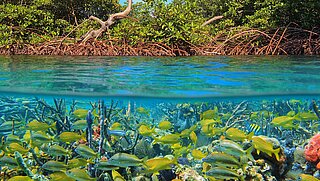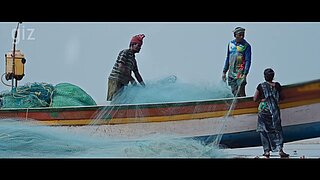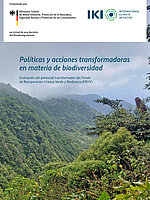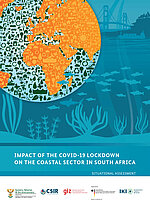Implementation of the GBF targets through IKI projects

The Kunming-Montreal Global Biodiversity Framework (GBF) comprises four long-term strategic goals and 23 action targets for the protection and sustainable use of biological diversity.
Overview on the 23 action targets
- Spatial planning & reducing losses
- Restoration of ecosystems
- Conservation and protection of ecosystems
- Conservation of species
- Harvest, trade and use of species
- Invasive alien species
- Pollution
- Biodiversity and climate change
- Sustainable use of wild species
- Sustainable management of areas & productive systems
- Ecosystem functions and services
- Green and blue spaces in urban areas
- Access and benefit sharing
- Mainstreaming biodiversity across sectors
- Business and biodiversity
- Sustainable consumption
- Biosafety
- Subsidies and incentives
- Financial resources for biodiversity
- Capacity-building and development
- Information and knowledge
- Participation of IPLCs
- Gender equality
Collective action is needed to achieve these targets. The IKI has globally already implemented projects with a focus on biodiversity conservation, therefore contributing to achieving the targets of the GBF. This article sheds light on four examples.
Protection and integrated coastal zone management of coastal and marine biodiversity (TerraMar)

The IKI project TerraMar, implemented by the GIZ, addresses various GBF targets through their work in Pernambuco, Brazil. For instance, in the Formoso River Estuary, unique mangrove and marine ecosystems exist along with endangered plant and animal species. This region also plays a vital role in providing livelihoods for traditional fishing communities. To reconcile the socioeconomic interests of tourism and traditional fishing with biodiversity conservation in the area, TerraMar supported environmental agencies in developing participatory environmental management processes. One such initiative is the Territorial Zoning of Nautical Activities (ZATAN) in the Formoso River Estuary, which involves a variety of stakeholders, including public authorities and local fishing communities. It also integrates traditional knowledge into conservation approaches addressing targets 1, 3, 4, 20 & 21. Additionally, TerraMar provides capacity development for biodiversity monitoring, social and environmental management, as well as fisheries management, contributing to target 22.

To adopt a gender-sensitive approach, TerraMar helped strengthen two networks of approximately 600 traditional fisherwomen, in the region Costa dos Corais and in the state of Bahia. This was achieved through a series of trainings, participatory workshops and technical assistance, in alignment with target 23. Recognizing the detrimental effects of inadequate waste disposal on land, particularly the impact of plastic waste on marine ecosystems and biodiversity loss, the project supported the development of the Action Plan to Combat Marine Litter in the state of Pernambuco (Pacolmar). Furthermore, TerraMar applied the waste flow diagram to identify and quantify plastic waste leakage into the environment, subsequently developing recommendations for its reduction, in line with target 7.
The Global Peatlands Initiative: assessing, measuring and preserving peat carbon
While peatlands occupy only three percent of the global land surface, they store about 30 percent of the terrestrial carbon, which is twice as much as all forests combined. As a result, they play a crucial role in the fight against climate change. Healthy peatlands are also essential for preserving biodiversity. Many of the peatland species are highly specialised and are not found in other habitat types. Intact peatlands are home and refuge to rare, migratory and threatened species such as orangutans, gorillas, the Sumatran tiger and the Aquatic Warbler (target 4). They even support biodiversity beyond their borders by regulating water flows in surrounding areas. Protecting the integrity, connectivity and resilience of these ecosystems (targets 1 & 2) – is the primary goal of the Global Peatlands Initiative. This helps to prevent biodiversity loss and contributes to global climate regulation (targets 8 & 11).

The Global Peatlands Initiative was formed at the end of 2016 and works towards global peatland preservation and restoration on both global and national level (targets 2 & 3). At the global level, the initiative developed a comprehensive assessment of the extent, state and importance of peatlands for climate and biodiversity. In four pilot regions, namely Indonesia, Peru, Democratic Republic of Congo and the Republic of Congo, the initiative provides knowledge and capacities on how to successfully restore, protect and sustainably manage peatlands (targets 2, 3, 20, 21).
Wetlands management for biodiversity and climate protection

The project supports the integrated management planning (target 1) of different sites protected under the Ramsar Convention, for example the Pong Dam Lake in Himachal Pradesh (target 3). Several migratory bird species frequent this site as a wintering site (target 4). The lake system is used for irrigation, generation of hydropower and for flood regulation while also providing livelihood to local communities through fishing and tourism (targets 10 & 11).
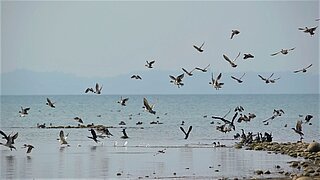
The project supports the integrated management planning (target 1) of different sites protected under the Ramsar Convention, for example the Pong Dam Lake in Himachal Pradesh (target 3). Several migratory bird species frequent this site as a wintering site (target 4). The lake system is used for irrigation, generation of hydropower and for flood regulation while also providing livelihood to local communities through fishing and tourism (targets 10 & 11).
Hutan Harapan: Consolidation of the first Ecosystem Restoration Concession (ERC) in Indonesia

"Hutan Harapan", or "Forest of Hope" in English, is the name of an Indonesian lowland rainforest, and the IKI project that conserves it. The project, implemented by KfW, covers a site of almost 100,000 hectares, managed by an international consortium consisting of NABU, KfW, RSPB, BirdLife International and Burung Indonesia. Together with indigenous people and local communities, the consortium conserves and restores this globally significant lowland rainforest and its ecosystem services for future generations - an important step to fight the biodiversity and climate crisis (targets 2 & 3). The area hosts an extraordinary diversity of flora and fauna and is one of the last refuges for many threatened species, among them several rare species of hornbills and primates (target 4).

The project places a strong emphasis on knowledge exchange and local agency (target 21). By working with local decision-makers and indigenous communities, including through a women's empowerment programme, the project fosters local ownership of the forest protection efforts (targets 22 and 23). This collaboration is vital for the conservation and restoration of the rainforest’s biodiversity, and the sustainable development of the region. In addition, an extensive monitoring system of flora and fauna aims to reduce knowledge gaps about biodiversity and gather long-term information on the populations and ranges of selected species.
The link has been copied to the clipboard
Contact
IKI Office
Zukunft – Umwelt – Gesellschaft (ZUG) gGmbH
Stresemannstraße 69-71
10963 Berlin
Further information
Biodiversity and climate action in the IKI
Related Videos
Related Publications
-
 08/ 2024 | Educational material
08/ 2024 | Educational materialThe Mysterious Mangroves of Bhitarkanika – A Children Book
English (PDF, 16 MB)



